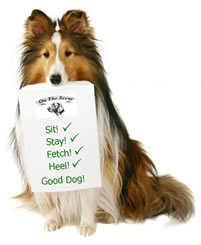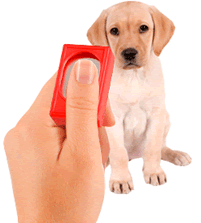Types of Training
Dog behavior training can be broken down into two general purposes. The first is training basic manners, or behaviors that you "do" want your dog to perform on command such as "sit", "stay", "down", "come", and walk nicely on a leash. The second purpose is training the "don't do" behaviors such as don't jump, don't pull on the leash, and don't run away.

Training the basic manners behaviors - "Do"
Lure-reward training:
The trainer lures the dog into the desired position with a treat. The dog follows the treat into the desired position. When the desired behavior is completed, reinforcement is showed by giving the dog the treat along with verbal praise.
Compulsion-praise training:
The trainer physically moves the dog into the desired position. Reinforcement is given with verbal praise and/or a food reward.

Marker-training:
The trainer uses a sound, word, or clicker to immediately 'mark' when the dog correctly performs a behavior. The marker is followed by reinforcement with food and/or verbal praise.
Reducing the undesirable behavior - "Don't"
Train a replacement "good" behavior:
The new behavior replaces and prevents the unwanted behavior. For example, to eliminate jumping up to greet, a dog can be taught to sit when the owner walks through the door and the new sitting behavior is rewarded.
Undesirable consequences:
The trainer can introduce consequences when a dog knows a routine behavior, but is being non-compliant. Consequences can also be used to reduce undesirable behaviors when a replacement behavior is not effective. Consequences help to reduce or eliminate the likelihood of the behavior recurring.
- Negative punishment(good things stop) - the trainer removes something desirable (such as food , toys, or attention) from the dog.
- Positive punishment (bad things happen) - an undesirable consequence (such as sharp verbal reprimand or correction collar) is immediately paired with the dog's undesirable behavior.
*Check out the video below that talks more in-depth about what dog training is, why it's so important, suggests tips to get started with your own training, and the benefits of having an obedient dog.